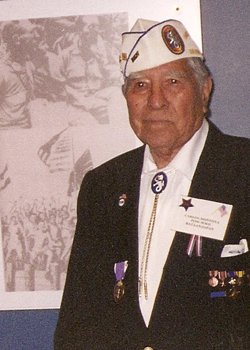Carlos Montoya
Carlos is a former POW and survivor of the notorious Bataan Death March. Originally from Albuquerque NM, he
was sent with the 200th Coast Artillery to the Philippines before WW11 and was at Camp Stotsenberg when it was
attacked by the Japanese immediately after Pearl Harbor
After fighting down the peninsula for four months, the
defenders of Bataan, U. S. Army and Philippine Army soldiers were commanded to surrender to the Japanese.
Completely out of food and ammo, they reluctantly followed orders and were captured.
Near the town of Marivales at the tip of the peninsula, the Japanese sent Carlos along with thousands of others
through searing tropical heat and humidity with no water and no food and the psychotic Japanese beating and
bayoneting as many men as they wanted to.
After five days of torturous marching, Carlos and the others were packed like sardines into tiny rail cars for a 20
mile stretch of track between San Fernando and Capas. The cars were so packed with men that many died
before they reached the station at Capas; where they were unloaded from the cars and marched the last six miles
to Camp O'Donnell.
There was almost no water for the prisoners, and during his time there, Carlos became ill with dysentery and was left for dead in a room at the camp infirmary called "zero ward". He summoned the strength to crawl back to his unit and with some help from a friend, he was able to heal himself enough to volunteer for a work party.
He
wanted to get out of the camp that he felt was a death trap.
He worked through the summer on a road through the jungle and after 3 months, out of 300 men on the detail,
Carlos was one of 48 who survived. He went from there to Bilibid Prison and then to Camp Cabanatuan before he
was shipped to Japan aboard a freighter like cattle. In Japan he was transported to the northwestern coast where
he worked like a pack mule loading coal in the town of Niigata.
He spent the rest of the war in Niigata Camp 5B and there was a guard at the coal yard that singled him out for
special beatings and torture. Carlos grew to hate this guard and in 1972, long after he was liberated, he returned
to Japan with a pistol intent on revenge.
His revenge was denied him, however, and he couldn't locate the guard. He was also there for the '72 Olympics, so the trip wasn't a total waste. He now lives in San Diego with his wife Betty, alive and still kicking at 93 years.
